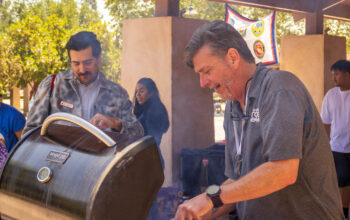Vanessa Sahawi
Binh Danh hits the Target
On Sept. 22, the art room opened their doors to a grand audience awaiting to see the guest lecture speaker Binh Danh. As the seats filled, a man with a blue collar shirt and friendly smile greeted everyone walking to their seats.
” I first met Binh through a photograph taken by his family before leaving Vietnam while making a label copy for History San Jose,” Monika Del Bosque, Pierce College Gallery director and assistant professor of art said during her introduction.
Danh lived in Northern California and is well known for his photography, but began his work in art installation. He currently has four art shows at work in Oakland, San Francisco, Nevada and North Carolina.
During the lecture Danh discussed many historical events, spirituality, religion, and philosophy concepts. He used picture imagery to help tell the stories of the holocaust, Cherokee “Trail of Tears,” and the Vietnam Memorial; these three examples made an individual who they are and the history behind it.
” I believe we could live a better life, if we reach nirvana it can teach us compassion and to be kind to others,” said Danh.
The use of photography is used to help understand ones past and how far one has come. Danh gave the audience a glimpse into his life as a Vietnamese refugee, the Vietnam War and the struggles that many faced during these gruesome times of war.
He explained the significance of a photograph during these times and the how it affected his family. The arranged marriage of his mother and father was because of a portrait sent and taken of his mother.
Many soldiers carried photographs to be identified if killed during the war and for those migrating to the United States, the photograph gave a value of a person sense worth.
” To keep the people in the photograph alive and captures a slice in time,” said Danh.
The pictures displayed during his presentation became inevitable that war does exist in our history and one needs to remember their past to move forward.
During his years in college Danh invented chlorophyll print. Chlorophyll print was designed to have a picture image imprinted into a tropical leaf.
The process begins by taking a negative film and placing it upon a leaf and exposing it into the sun. The negative film is kept outside for several days and the once peeled off it would be imprinted on the leaf.
The philosophical viewpoint behind the chlorophyll print is to have a stronger relationship with mother nature and to be close to roots of life, said Danh. ” If the grass could talk what stories would they tell and what would they say about us.”
The guest lecture left many of us with many thoughts, questions and ideas to be thought of.
As lecture was completed the audience flooded to the Art Gallery to see Danh’s art installation. The gallery was lively with familiar faces as well as new ones who were interested in see the art work.
” It’s showing you that after a couple of years the aftermath (of the Vietnam war) from agriculture, way of life. People collecting tanks restored in concrete. Ideas is very subtle, the vases that look like bombs,” said Gustavo Tepetla, returning freshman.
Outside of the gallery the court yard was filled with discussions of the art pierces and viewpoints that some of the audiences had with art installation.
“I saw the art exhibit and I viewed it as anti militaristic. I felt offended. I feel that the marines, army, navy and others shouldn’t be portrayed that way. We don’t really understand what the soldiers go through,” Arvin Aquino, freshman stated.
” I’ve come to the conclusion, that it’s not the artist, it’s the viewer. The viewer might have some personal take on my work but it’s the viewer who makes the opinion. I just place my work and it’s the viewer who takes the interpretation,” said Danh about the topic of criticism of his artwork.



